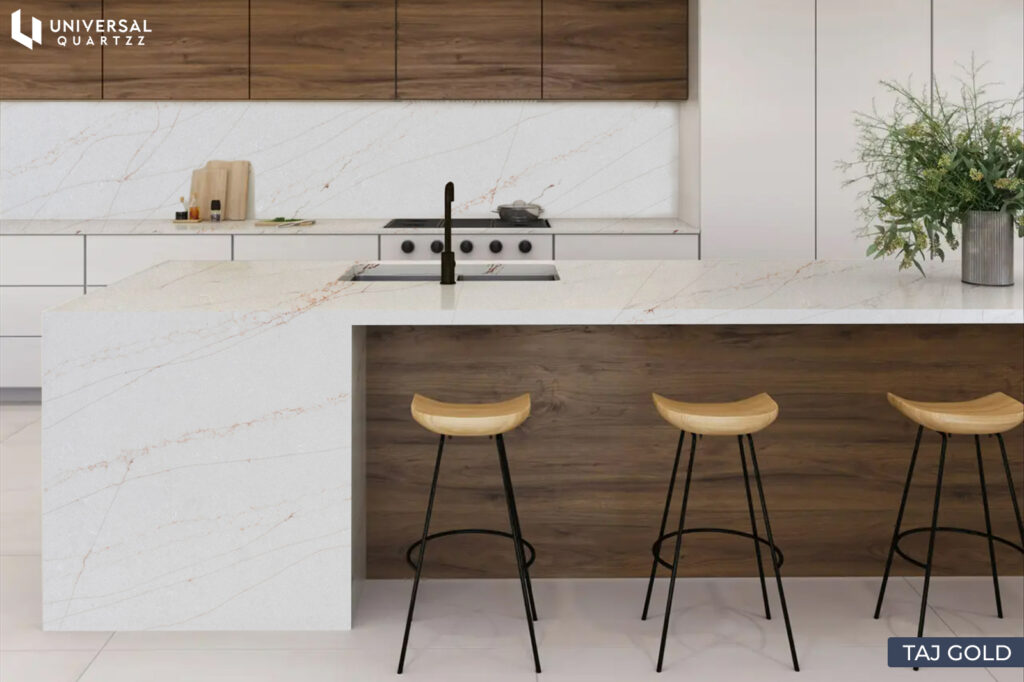Calacatta gold quartz is a high-quality material often used for countertops, and it can be a big investment for your home. It’s known for being strong, durable, and resistant to stains, making it a practical option. Plus, its beautiful design can easily become the centerpiece of any room.
What is Calacatta gold quartz?
Calacatta gold quartz, an engineered surface, blends approximately 90% quartz stone with 10% added resins, polymers, and pigments, enhancing the quartz’s natural beauty with extra durability from synthetic materials.
Renowned for its luxurious charm. Calacatta gold quartz elevates any space it occupies. It showcases a delicate white base complemented by veins in beige, gray, or gold, offering a bold, clean, and luminous aesthetic. This versatility makes it ideally suited for a myriad of indoor applications, including kitchen countertops, shower surrounds, backsplashes, and bathroom vanities.
What Colour Calacatta Quartz Comes In?
Calacatta quartz has a crisp, dazzling white color with grey-blue veining. In most cases, the veining is thick and dramatic. Extra hues, such as golds and browns, are tossed in with some Calacatta varieties. Popular Calcatta quartz varieties are shown in the images below.
What Is The Price of Calacatta Quartz?
Calacatta quartz costs between $60 and $100 per square foot. The price may vary depending on the thickness and type. Each type of Calacatta quartz is distinct, which might increase the cost, especially if you want a specific aesthetic.
Getting them in larger pieces might be difficult (and consequently more expensive), so buying them in tiles rather than slabs can save you money.
Calacatta Quartz is on the more expensive side of the spectrum. Therefore it might be worth it to go all-in and acquire the whole slabs to truly make an impact in the space it will be utilized in.
When considering the cost of the supplies, keep in mind that you’ll need to budget for an installation (which will be more expensive depending on the complexity level) and any slab cuts. The cost of a normal slab of Calcutta Quartz, including installation, is typically between $70 and $100.
This varies depending on the size, shape, location, and merchants. In some circumstances, more than one slab may be required, which will obviously increase the cost. Which will often double because an additional slab is being purchased.
Which Calacatta Quartz Is The Best?
There are many types of Calacatta quartz and the variety doesn’t change a lot in the quartz material. In some of the quartz the pattern changes or the amount of grey veins changes.
The quality and strength of the material remain similar. The change of thickness and length of the slab can change.
While Calacatta is a form of quartz in and of itself. There are subcategories of Calacatta quartz with modest color and veining variances.
There are a lot of options for patterns, subtle shade variances, and the quantity of translucence in each piece, so any design can have the right Calacatta quartz pieces.
Pros and Cons of Calacatta Gold Quartz
As with any countertop material, Calacatta gold quartz comes with its set of advantages and disadvantages.
Pros
Beauty: The aesthetic appeal of Calacatta gold quartz is one of its primary strengths. Its understated base hue renders it a versatile foundation for a multitude of design schemes, while the distinctive veining allows for the introduction of accent colors via paint, appliances, and finishes. Modern manufacturing techniques mean this material is available in a vast array of color and pattern options, catering to diverse design tastes.
Durability: Engineered for enhanced resilience, Calacatta gold quartz outperforms natural stone in strength and sturdiness. The incorporated resins and polymers endow it with superior resistance to chips, scratches, and breaks. This renders it an ideal surface for busy kitchens and bathrooms, places that demand a material capable of withstanding constant use.
Non-porous: Contrary to natural stones like granite and marble. Calacatta gold quartz is non-porous by nature. It repels water, moisture, and other liquids, preventing stains and discoloration. This resistance to liquid absorption, even from potent staining agents like red wine and coffee, makes it a sought-after choice for kitchen counters where spills are common. Its inability to absorb also means it does not promote the growth of mold, bacteria, or mildew, contributing to a more hygienic environment for food preparation.
Cons
Price: A notable drawback of Calacatta gold quartz is its cost. You’ll find that the expense for this type of quartz countertop is higher compared to other manufactured materials. Yet, the investment can be worthwhile considering Calacatta gold quartz’s remarkable durability and resistance to staining. Which translates to a longer lifespan in your home without the need for frequent replacements.
Sunlight Discoloration: Another potential issue is that prolonged exposure to direct sunlight can lead to discoloration of Calacatta gold quartz slabs. This might detract from the slab’s exquisite veining and pattern details. To mitigate this, it’s best to use quartz countertops for indoor settings and position them in areas not subject to constant sunlight.
Heat Damage: While it does offer some resistance to heat. Calacatta gold quartz is not as resilient to high temperatures as some natural stone options. It can withstand heat only up to about 150 degrees Fahrenheit; exposure to higher temperatures or for extended periods may cause damage. Protecting your Calacatta gold quartz countertops from direct contact with hot items will help maintain their aesthetic appeal.


